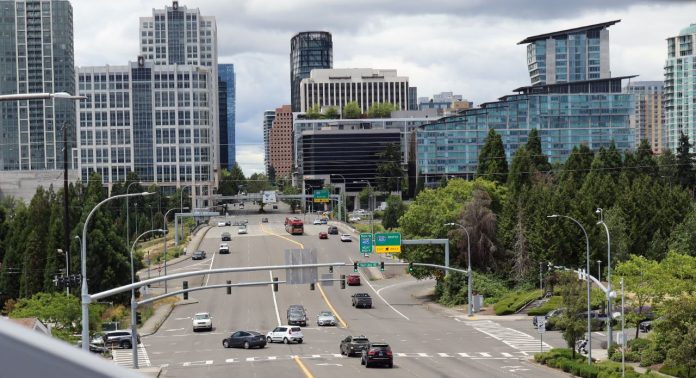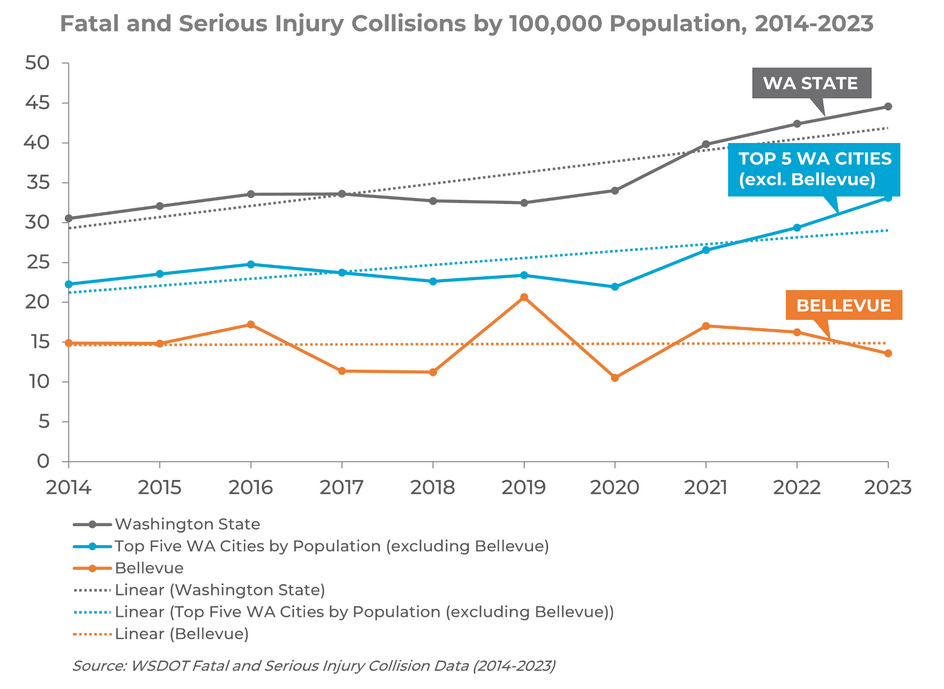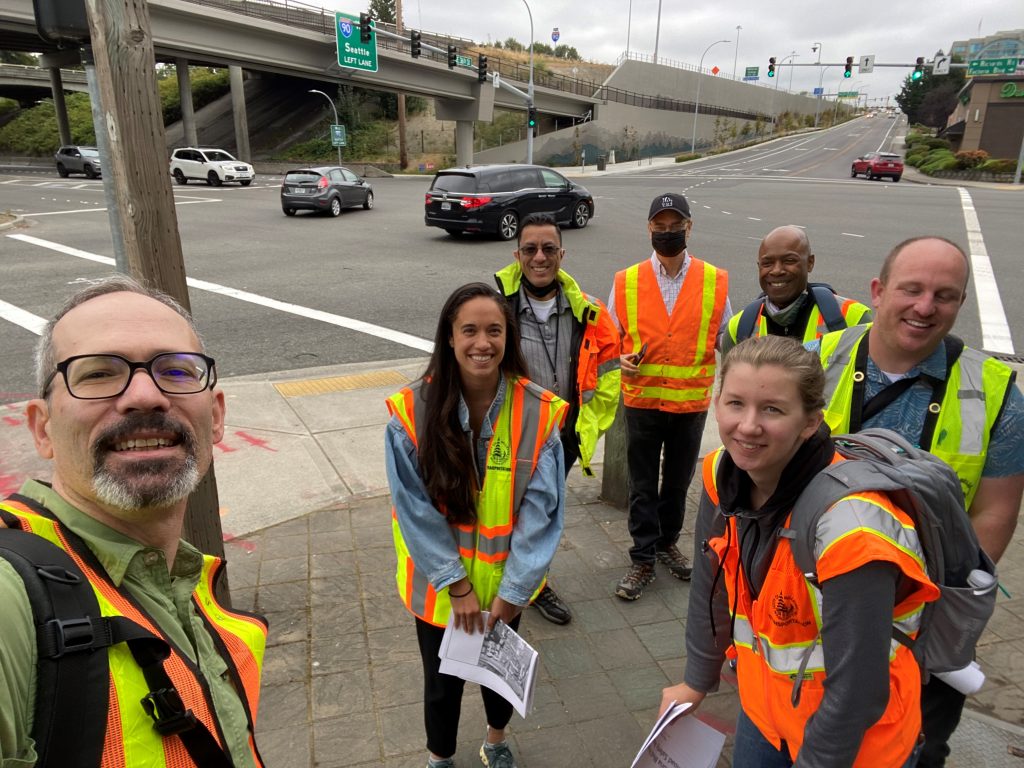
As cities in our region spring headfirst into budget season, few places find themselves in the healthy fiscal position that the Eastside’s largest city is in. During a budget presentation back in July, Bellevue’s City Manager Diane Carlson touted the city’s diverse revenue sources and stable finances as optimistic indicators for the upcoming biennium. These circumstances strongly contrast with those of other cities around the region who are contending with constrained revenue and mounting deficits.
It’s not just its financial situation that could lead one to be bullish on Bellevue. Since 2 Line light rail service began in April through the East Link starter line, ridership has exceeded expectations, and more people will surely hop on when connections to Seattle and Downtown Redmond open next year. Council is about to pass an ambitious Comprehensive Plan that many view to be bolder than that of Seattle, which will dramatically increase housing capacity and availability in this expensive community.
Plus, Bellevue has ample nonprofits, community organizations, and neighborhood groups that each contribute to a robust and healthy civic fabric by engaging on issues of environmental stewardship, racial equity, community safety, unique place-making, and more. For many in Bellevue, the vibes are good.
However, vibes alone do not guarantee a high-quality city, nor are they a substitute for good policy making. Tangible outcomes and data are important to ensure we’re meeting the objectives that the city has committed itself to (and that the public expects the city to achieve). Bellevue needs both the leadership and financial resources to ensure that its values of public safety and environmental stewardship translate into material results that improve the lives of the city’s residents.
One of the clearest data-oriented objectives the city has publicly committed itself to is Vision Zero – a pledge to completely eliminate serious injuries and fatalities on city streets by 2030. Bellevue first passed this pledge back in 2015 under the leadership of then-Mayor Claudia Balducci, who was motivated to action after a toddler was killed in a crash on Bel-Red Road.
The Vision Zero paradigm acknowledges that tragedies like this one and the dozens that occur every year on Bellevue streets are unacceptable, because none of us should lose our loved ones to an unsafe transportation system. Furthermore, Vision Zero recognizes that we achieve these poor outcomes because we have engineered a system that, through high speeds and conflict points, subjects human bodies to collisions that they cannot survive. Finally, because we know that humans are imperfect and will make mistakes, a Vision Zero approach seeks to create a better system where it is not possible for a collision to end in a loss of life.
To be clear, these are not just aspirational, feel-good statements that can never be achieved, and it’s clear from repeated community engagement on this issue that constituents do not view them as such. Bellevue leaders have set this goal because they recognize that many cities around the world, including right here in the United States, have achieved Vision Zero through safer street design, lower speeds, and more facilities for people walking and biking. As a city that has always prided itself on a robust public safety apparatus in the form of well-funded police and fire departments, there is an increasing understanding among city leadership that true community safety extends to the design of our transportation infrastructure — capital investments that are beyond what can be addressed with a badge and sirens.
However, despite these changes in thinking, we are not achieving the results we need to see. Bellevue’s Vision Zero progress has significantly stalled, and the city’s 10-year trend line of deaths and serious injuries is currently flat. Stated differently: since we first committed ourselves to Vision Zero 10 years ago, the actions we’ve undertaken have not been enough to meaningfully change course.

Where there is room for optimism is how Bellevue’s numbers stack up in comparison with other Washington cities. Where cities like Seattle are seeing deaths and serious injuries climb in spite of Vision Zero pledges, Bellevue’s suite of actions — from innovative technologies to signal modifications and more — have contributed to the current holding pattern.
Thus, Bellevue finds itself in a position where additional strategic investments can move the needle and shift that trend line downwards. With careful planning and adequate resources, Bellevue can be the first major West Coast city to achieve its Vision Zero pledge. This is why 10 Eastside advocacy organizations — from safe streets coalitions to environmental groups to racial justice organizations and more — have called upon Bellevue leaders to recommit to Vision Zero in the 2025-26 Operating Budget and 2025-34 Capital Improvement Program (CIP) Plan. To make this year the year we implement a “Vision Zero Budget” and get back on track towards our shared safety goals, our organizations have urged the city to, among other things:
- Fully fund the scoping, design, and implementation of rapid-build school safety projects. We know that vulnerable road users — people walking, biking, and rolling — are disproportionately impacted by traffic violence. To support children who walk and bike to school, Bellevue Transportation staff partnered with community members to evaluate streets around 12 schools for potential safety improvements. These evaluations have generated a list of over 300 project proposals that the city could implement to improve the safety of everyone who travels in these areas. These improvements would make it safer for kids to travel on foot and on two wheels, increasing their independence while reducing traffic congestion around schools.
- Commit to the rapid deployment of bicycle and transit infrastructure. We know that better infrastructure for people biking and taking transit encourages more people to use these modes, and we know that safety increases as car mode share decreases. We also know that municipal governments are slow; the infrastructure we plan for and fund now will determine what our mobility network looks like by our 2030 Vision Zero deadline. Bellevue should counteract these pressures by committing itself to the cost-effective, rapid deployment of bike facilities, transit lanes, and other multi-modal infrastructure. The city has plans and programs in place, like the Rapid Implementation Initiative and the original Bike Bellevue Design Guide, that it can draw upon to support the rapid deployment of Vision Zero infrastructure.
- Pass a Vision Zero Transportation Benefit District (TBD) to fund safety improvements. We know that trying the same thing and expecting different results is not a path towards success. Existing resources and programs have been insufficient to achieve progress, so Bellevue should draw upon community resources to fund community values. In 2023, Bellevue City Council created a Transportation Benefit District, a legal entity that gives the city authority to levy a tax towards transportation improvements. The city could use this authority to generate up to $10 million annually, which is more than the projected annual revenue of the existing transportation levy, at a cost of just $2.50 per month to the average Bellevue family. Officials might understandably be wary of passing a new tax the year before municipal elections, but proper framing can be helpful. If officials use their time on the dais to clearly inform constituents how a Vision Zero TBD will lead to improved crosswalks, more options to get around, and safer streets in their neighborhood, we believe the community support will follow.

Bellevue’s existing plans, knowledgeable staff, and extensive resources leave the city poised to move forward on transportation safety — but the equal potential to move backwards cannot be overstated. Because of pressure fomented by the city’s resident billionaire and wealthy developers, city leaders and staff have significantly walked back the Bike Bellevue project that would have improved safety on 15 miles of the city’s most dangerous streets. That backsliding means that building bicycle facilities on streets like Northup Way — full of businesses, apartments, and community destinations — will rely on a longer-term, patchwork approach that will create safer infrastructure only as neighboring parcels redevelop.
Relying on developers to fund bike infrastructure along unclear and unstable timelines, rather than using the city’s purse to increase safety for all road users, is not a Vision Zero approach.
Government is often in the business of trade-offs: weighing competing constituent priorities to arrive at outcomes that are the least bad to the fewest number of people. However, Vision Zero is one of the few issues where we can have it all and not make sacrifices. We can have safe streets and improved mobility, including reduced congestion for motor vehicles. We can have safe streets and a strong, vibrant economy. We can have safe streets and a clean, healthy environment. It is in everyone’s best interest — including those of our elected officials and business leaders — to show a commitment to the achievable future where nobody loses their life on a Bellevue street.
Bellevue may have the best vibes around, but to residents and workers of the Eastside’s largest city, its true success will be measured in how well its leaders can cut through the vibes and marketing to focus on policies that will truly create better circumstances for us all.
Chris Randels is the founder and director of Complete Streets Bellevue, an advocacy organization looking to make it easier for people to get around Bellevue without a car. Chris lived in the Lake Hills neighborhood for nearly a decade and cares about reducing emissions and improving safety in the Eastside's largest city.

